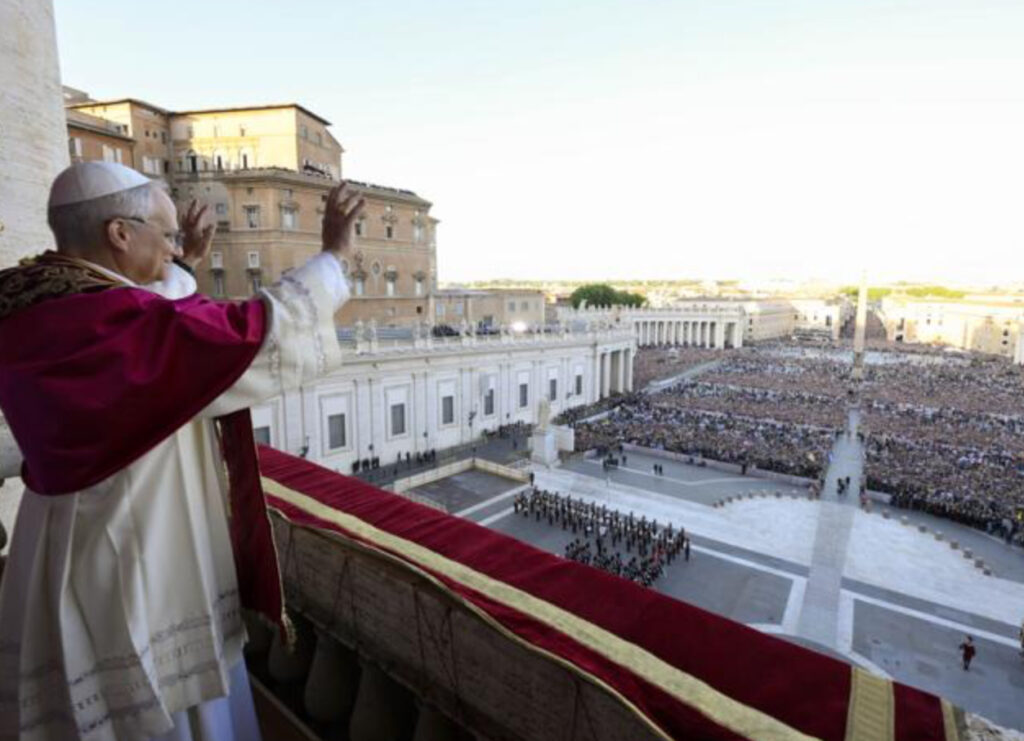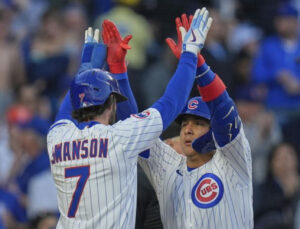Chicago Cubs’ Miguel Amaya (9), right, high-fives Dansby Swanson after Amaya hit a two-run home run during the third inning of a baseball game against the San Francisco Giants, Tuesday, May 6, 2025, in Chicago. (AP Photo/Erin Hooley)
Last Thursday, the Vatican elected Robert Francis Prevost—Villanova Class of ’73 and a former mathematics major—as the 267th pope of the Roman Catholic Church. Taking the name Pope Leo XIV, Prevost is not just the first American to hold the title but also, as far as records show, the first pope with a degree in applied mathematics. It’s a historic moment for the Catholic Church, the United States, and, unexpectedly, a massive PR win for Villanova.
The timing of the papal announcement couldn’t have been better for another group of Wildcats making headlines: the “Nova Knicks.” Led by Villanova alumni Jalen Brunson, Josh Hart, and Donte DiVincenzo, the Knicks have jumped out to a stunning 2–0 series lead over the Boston Celtics in the Eastern Conference Finals. As the series shifts back to Madison Square Garden, belief is surging in the team—and some fans are crediting divine intervention.
“You can’t make this up,” says Leo Cavallo, a Knicks season ticket holder who also happens to be a theology professor. “The pope is from Villanova. Three of our guys are from Villanova. And now we’re two wins away from the Finals. If you don’t believe in miracles, I don’t know what to tell you.”
The irony, though, is thick. Villanova’s recent cultural ascendancy—complete with a new pope, playoff stars, and an elite basketball legacy—still hasn’t earned it the one recognition it’s long craved: being accepted as a true Philadelphia institution.
The Catholic College on the Outside
Founded in 1842 by the Augustinians, Villanova University sits just over the city line, nestled in the leafy suburb of Radnor Township. It’s about a 25-minute train ride from Center City, but that hasn’t been enough to secure it a place in the hearts of many Philadelphians. Unlike the University of Pennsylvania, Temple, or even Saint Joseph’s, Villanova is seen as too polished, too privileged, and just a little too Main Line for gritty, working-class Philly.
“There’s always been this perception of Villanova as being apart from Philadelphia,” says Dr. Yvonne Carmichael, a historian at Temple. “It’s not just geography. It’s cultural. It’s racial. It’s economic. Villanova feels like a school for the suburbs, not the city.”
That tension has defined Villanova’s identity for decades. On the one hand, its basketball team plays in the Big East and draws crowds from across the region. On the other, it’s never quite matched the street credibility of a Temple or La Salle, schools that produce players from urban Catholic League powerhouses. Villanova recruits nationally. It attracts legacy students. It’s buttoned-up, well-funded, and increasingly elite.
“Villanova is Catholic Ivy,” says Philly sports journalist Ray Didinger. “But Philly doesn’t love Ivy. Philly loves scrappers.”
And yet, the contradictions are everywhere. Villanova thrives off its Philly connection when it’s convenient—especially during March Madness runs. Local media frame its victories as Philadelphia’s victories. The “Philly Big 5” includes Villanova. But Villanova students rarely venture into the city. The school doesn’t participate in the political or social life of Philadelphia in any significant way. Its ties to the city are mostly athletic and mostly superficial.
Papal Blessing or PR Windfall?
With the elevation of Pope Leo XIV, Villanova has a genuine claim to global spiritual influence. Prevost isn’t just any alumnus; he’s a career missionary, a polyglot, and a veteran of the Vatican bureaucracy. He represents Villanova’s deeply rooted Catholic identity, something the school often embraces more in marketing than in mission.
“Villanova talks about its Augustinian values all the time,” says a former campus minister who asked not to be named. “But it also competes with Georgetown, Notre Dame, and Boston College. That means fundraising, rankings, prestige. There’s a tension between its Catholic roots and its ambitions.”
Prevost’s election brings those two forces into harmony—for now. It offers a symbol of moral authority that transcends basketball games and rankings. Villanova’s president, Rev. Peter Donohue, called the moment “a blessing and a testament to the power of faith and education.” Social media feeds lit up with Wildcats pride, with memes joking that “God is a Nova fan.”
But some critics see the celebration as opportunistic. “The Church is in crisis,” says Mari Hernandez, a Catholic activist. “Yes, it’s cool that the pope went to Villanova. But are they going to use that as a reason to revisit how they handle things like sexual abuse, racism, or labor issues? Or is it just branding?”
Still, the symbolic resonance of a pope from your alma mater can’t be denied—especially not when your basketball team is peaking at the same time.
Knicks Revival, Powered by Nova
The term “Nova Knicks” began as a tongue-in-cheek nickname, but it’s taken on serious weight as Brunson, Hart, and DiVincenzo have gelled into one of the most cohesive trios in the NBA. All three played under coach Jay Wright and won national titles at Villanova. All three embody the unselfish, tough, team-first style that Wright made famous.
Brunson, in particular, has become a breakout star. After being snubbed by All-NBA voters last season, he’s put together a playoff run that rivals any in recent memory. He’s averaging 32.7 points per game in the postseason, hitting big shot after big shot, and drawing comparisons to past New York legends.
“He’s the most Villanova player ever,” says sportswriter Zach Lowe. “Disciplined, prepared, patient, clutch. It’s like watching a surgeon with a jump shot.”
Hart and DiVincenzo complement him perfectly—defending, rebounding, spacing the floor, and occasionally going off for double-doubles of their own. The chemistry is evident, and the fact that they share a college bond only adds to the mystique.
“Villanova taught us how to win,” Hart told reporters after Game 2. “It’s not about who scores. It’s about doing the right thing every play. That’s how we were coached. That’s how we play.”
The Knicks’ success feels like the ultimate validation of Jay Wright’s program—not just its skill development but its culture. It’s not hard to draw a straight line from the Villanova locker room to the Knicks’ resurgence.
The Identity Crisis That Won’t Go Away
And yet, amid all this success, Villanova’s identity remains in limbo. The pope and the playoffs have boosted its profile, but they haven’t solved its long-standing existential question: Is Villanova a national Catholic powerhouse or a Philly school with Catholic flavor?
“In a weird way, Villanova is having its moment, but it’s still trying to figure out what it is,” says education sociologist Dr. Marcus Knowles. “It wants to be global, but it also wants to be local. It wants prestige, but it also wants Philly’s approval. That’s hard to reconcile.”
The papacy and the playoffs won’t settle that debate. They may even amplify it.
There’s also the demographic shift. Villanova’s student body is wealthier and whiter than most of the region’s other colleges. Its growing national reputation means it draws more from the coasts and less from the city. And while it talks about inclusion and diversity, its footprint in Philly neighborhoods remains limited.
“Villanova gets to claim Philly when it’s convenient,” says Knowles. “But it’s not embedded here. Not like Temple or Drexel or even Penn. And certainly not like Saint Joe’s, which still plays half its games in a gym that feels like a high school auditorium.”
So while the Knicks and the Vatican celebrate, the question lingers: will Villanova ever really be accepted as part of Philadelphia?
What Happens Next?
Villanova doesn’t need to do anything. The pope isn’t going anywhere. The Knicks may or may not win the Finals, but their Villanova trio will remain central to the team’s identity for years to come. From a branding perspective, the school is winning.
But if Villanova wants more than attention—if it wants connection—it has work to do. That means investing in the city, not just claiming it. Building partnerships. Offering scholarships. Supporting Philly’s public schools. Being more than a train ride away.
Until then, it will continue to straddle the awkward space between regional affection and national ambition. It will keep claiming Philly when it suits, even as the city keeps it at arm’s length.
Still, in this strange moment—when a Villanova grad sits on the papal throne and three others run the floor at Madison Square Garden—it’s hard to deny the school’s rising profile.
Villanova may not be a Philly school. But right now, it is the school.
No comments yet.









